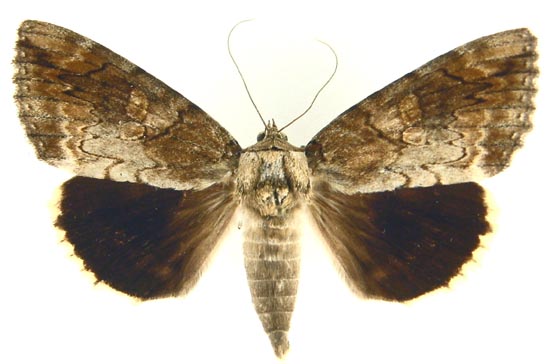Catocala atocala
Catocala atocala
kah-TOCK-uh-lahMah-TOCK-uh-lah
Brou, 1985

Catocala atocala (male-Louisiana)
courtesy of Vernon A. Brou.
This site has been created by
Bill Oehlke.
Comments, suggestions and/or additional information are welcomed by Bill.
| TAXONOMY:
Superfamily: Noctuoidea
Family: Erebidae, Leach, [1815]
Subfamily: Erebinae, Leach, [1815]
Tribe: Catocalini, Boisduval, [1828]
Genus: Catocala, Schrank, 1802
|
DISTRIBUTION:
Catocala atocala (forewing length: males: 33-37mm; females: 35-37mm), Brou's underwing,
(wingspan: mm) flies mainly in riparian floodplain forests from
Louisiana west to
Oklahoma and north to
southern
Illinois.
It has also been reported in
Arkansas,
Florida,
Mississippi,
Tennessee and
Texas.
In 2006 it was reported in western Kentucky.
Vernon A. Brou chose the species name (rhyming) to try "to do
something unique: atocala is simply Catocala
without the C. (ka-ta-ko-la a-ta-ko-la)"
The forewing is medium brown and light gray (males), or
white (females), with black postmedial, antemedial and basal lines.
There is a black subterminal
band from vein R4 to the anal angle. The area between the postmedial line and clearly defined
reniform spot above vein M2 is mostly black. The brown basal area is enclosed by a black (front)
and brown (rear) antemedial line. The area between the postmedial and subterminal lines
is strongly marked with brown. Colouration is slightly paler brown between reniform and ante
medial line in discal cell. Inner margin of forewing area between postmedial
and antemedial lines distinctly gray in males and white in females. This light area
extends basad of the antemedial line below vein A! in the form of a narrow band
paralleling curved antemedial line and continuing distance to base along inner
margin.
"The rear of the upper strongly marked portion of the antemedial
line of atocala is angled toward the anal angle or outer margin of the forewing,
unlike agrippina which is angled toward anal angle or inner margin. The antemedial
line intersects the costal margin distally on atocala compared to agrippina.
The reniform is more clearly defined in atocala. The closed subreniform of atocala
may be open or closed in agrippina. The distinct basal dash of agrippina females
is nearly absent in atocala females. The hindwing undersurface white areas on
agrippina are beige on atocala. The hindwing bulge (discal spot) on atocala, is
not present on agrippina." Vernon Brou
FLIGHT TIMES AND PREFERRED FOOD PLANTS:
Catocala atocala are usually on the wing in July and August.
The Catocala atocala caterpillar probably eats Juglans nigra
and Juglans cinerea, but it seems most strongly associated with Nutmeg Hickory (Carya myristiciformis).
ECLOSION:
Adults eclose from pupae at soil surface.
SCENTING AND MATING:
Catocala atocala females
emit an airbourne pheromone and males use their antennae to track the
scent plume.
EGGS, CATERPILLARS, COCOONS AND PUPAE:
Eggs are deposited on
tree bark in the fall and hatch the following spring.
Larval Food Plants
Listed below are primary food plant(s) and alternate food plants.
It is hoped that this alphabetical listing followed by the common
name of the foodplant will prove useful. The list is not exhaustive,
although some species seem very host specific.
Experimenting with closely related foodplants is worthwhile.
Carya myristiciformis .......
Juglans cinerea
Juglans nigra
|
Nutmeg Hickory
Butternut
Black walnut
|
Return to Main Index
This page is brought to you by Bill Oehlke and the
WLSS. Pages are on space rented from Bizland. If you would like to become a "Patron of the Sphingidae/Catocala Sites", contact Bill.
Please send sightings/images to Bill. I will do my best to respond to requests for identification help.
Enjoy one of nature's wonderments: Live Saturniidae (Giant Silkmoth) cocoons.

|

To show appreciation for this site, click on the flashing
butterfly to the left, a link
to many worldwide insect sites. |


